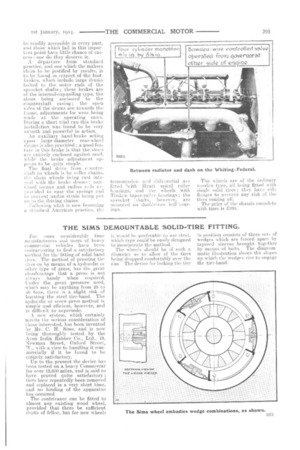THE SIMS DEMOUNTABLE SOLID-TIRE FITTING.
Page 7

If you've noticed an error in this article please click here to report it so we can fix it.
For some considerable time manufacturers and users of heavy commercial vehicles have been endeavouring to find a satisfactory method for the fitting of solid band -ires. The method of pressing the rites on by means of a hydraulic oi other type of press, has the great disadvantage that a press is not a lw us handy when required. Under the great pressure used, which may be anything from 25 to 40 tons, there is a. slight risk of bursting the steel tire-band. The hydraulic or screw-press method is simple and efficient, however, and is difficult to supersede'. A new system, which certainly merits the serious consideration of rhose interested, has been invented by Mr. C. H. Sims, and is now being thoroughly tested by the Avon India Rubber Co., Ltd., 19, Newman Street, Oxford Street, W., with a view to handling it commercially if it be found to be entirely satisfactory.
Up to the present the device has been tested on a heavy Commercar for over 12,000 miles, and is said to have proved quite satisfactory ; tires have repeatedly been removed and replaced in a very short time, and no binding of the apparatus has occurred.
The contrivance can be fitted to almost any existing wood wheel, providod that there be sufficient depth of felloe, but for new wheels would be preferable to use steei, which type could be easily designed to incorporate the method. The wheels should be of such a diameter as to allow of the tires being dropped comfortably over the rim. The device for locking the tire
in position consists of three sets of wedges which are forced apart by tapered sleeves brought together by means of bolts. The diagrammatic illustration shows the slopes UP which the wedges rise to engage the t ire-baud




















